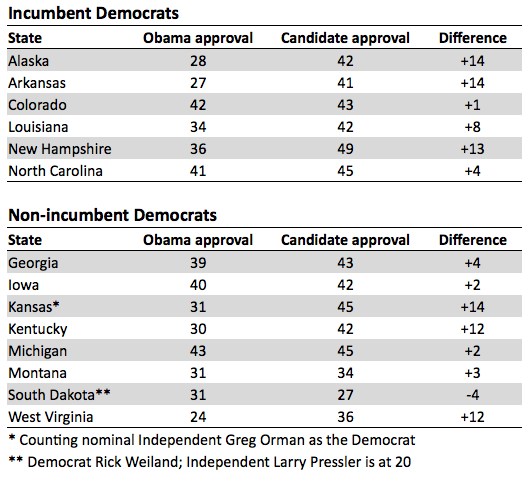At the Washington Post’s The Fix blog, Chris Cillizza has a good post with three charts showing how Democrats are in trouble in the 2014 Senate contests. The charts go back to the 2006 cycle when Republican Senate candidates, in Cillizza’s view and mine, faced a similar problem: an unpopular president from their own party.
The first chart shows how Republicans in seriously contested races failed to win percentages much above George W. Bush’s job approval in their states, with the single exception of Lincoln Chafee, who lost anyway in heavily Democratic Rhode Island. The other two charts show how late-deciding voters swung toward the out party’s challenger and how Republicans had a money advantage that year (as Democrats do this year).
Here’s my own chart showing Barack Obama’s job approval rating in each state with a serious Senate contest, according to New York Times/YouGov polling from Sept. 20 to Oct. 1, and the current standing of the Democratic nominee in each of those races, according to the RealClearPolitics average of recent polls, and the difference between the two numbers.

Comments:
1. Obama job approval is well below 50 percent in all 14 of these states. In only one state, Michigan, is it above the 42 percent job approval Obama was registering Oct. 1 in the RealClearPolitics average, and it is only slightly higher. This is true even though Obama carried three of these states — Colorado, Iowa and Michigan — in 2008 and 2012, and another, North Carolina, in 2008.
2. None of the Democratic candidates, including the six incumbents, in these 14 states is polling at 50 percent or above. Only one, Jeanne Shaheen in New Hampshire, is polling above 45 percent, and only two, Kay Hagan in North Carolina and nominal independent Greg Orman in Kansas, are polling at 45 percent. All others are below. Looking back over the past six Senate cycles going back to 2002, using data compiled by Dan McLaughlin at redstate.com, I found that only two incumbent senators who were polling below 45 percent at about this stage in the electoral cycle went on to win — Michael Bennet (chairman of the Senate Democrats’ campaign committee this year) in Colorado in 2010 and Jon Tester in Montana in 2012. Bennet was an appointed senator then, not yet elected to a statewide office; both Bennet and Tester got under 50 percent of the vote and won with pluralities.
Why should it be so hard for incumbents polling under 45 percent to win? Brad Dayspring and Brook Hougesen of the Senate Republicans’ campaign committee provide an explanation which, while self-serving, is also pretty convincing. “Voters who are familiar with an incumbent but do not support them on the ballot are essentially window-shopping for a new senator. That is why this group of voters traditionally breaks against the incumbent by a two-to-one margin (or stays home on Election Day). In other words, for every four undecided voters, one will typically vote for the incumbent, two will vote for challenger, and one will stay home. This means that for every point the incumbent is short of 50 percent, they need 4 percent of voters in the undecided category to make up for it. An incumbent Senator sitting at 45 percent in the polls needs undecided voters to total 20 percent in his or her state to make up for it, or the math just doesn’t work.”
If that rule is correct, it is uphill going for Mark Begich in Alaska, Mark Pryor in Arkansas, Mark Udall in Colorado and Mary Landrieu in Louisiana, and quite possibly for Hagan in North Carolina. Shaheen is definitely better positioned in New Hampshire.
As for non-incumbent Democrats, Alison Lundergan Grimes in Kentucky and Natalie Tennant in West Virginia are elected statewide officials and are running 12 points ahead of Obama job approval in their states. But Grimes has been trailing Republican incumbent Mitch McConnell pretty steadily in the polls (with one recent exception) and Tennant seems far behind in pursuit of a seat that no Republican has won since 1956. Michelle Nunn in Georgia, Bruce Braley in Iowa and Gary Peters in Michigan are running only barely ahead of Obama job approval, and must attract voters disapproving of Obama to win. Peters, who leads in recent polls in Michigan, the only one of these 14 states where Obama approval runs above the national average, obviously has a good chance of doing so; it will be tougher but not impossible for Nunn and Braley, who trail narrowly in recent polls.
Kansas and South Dakota are a different matter. The presence of nominal independent candidates, neither of whom has said which party he will support to organize the Senate, seems to have these races more volatile than the other 12. That’s good news for Democrats, who had considered these races lost causes four weeks and one week ago, respectively.
Then there is Montana. The hapless Democratic nominee, selected when appointed incumbent John Walsh resigned the Democratic nomination following revelations of plagiarism of a National War College thesis, is running not much better than even with Obama’s 31 percent job approval — in a state where he won 47 percent of the vote in 2008. The last time a Republican was elected to this Senate seat was in 1906, when the state legislature elected Republican Joseph M. Dixon. The voters of Montana have never elected a Republican to this seat (and have elected ones to the other seat only in 1946, 1988, 1994 and 2000); they seem sure to do so this year.

